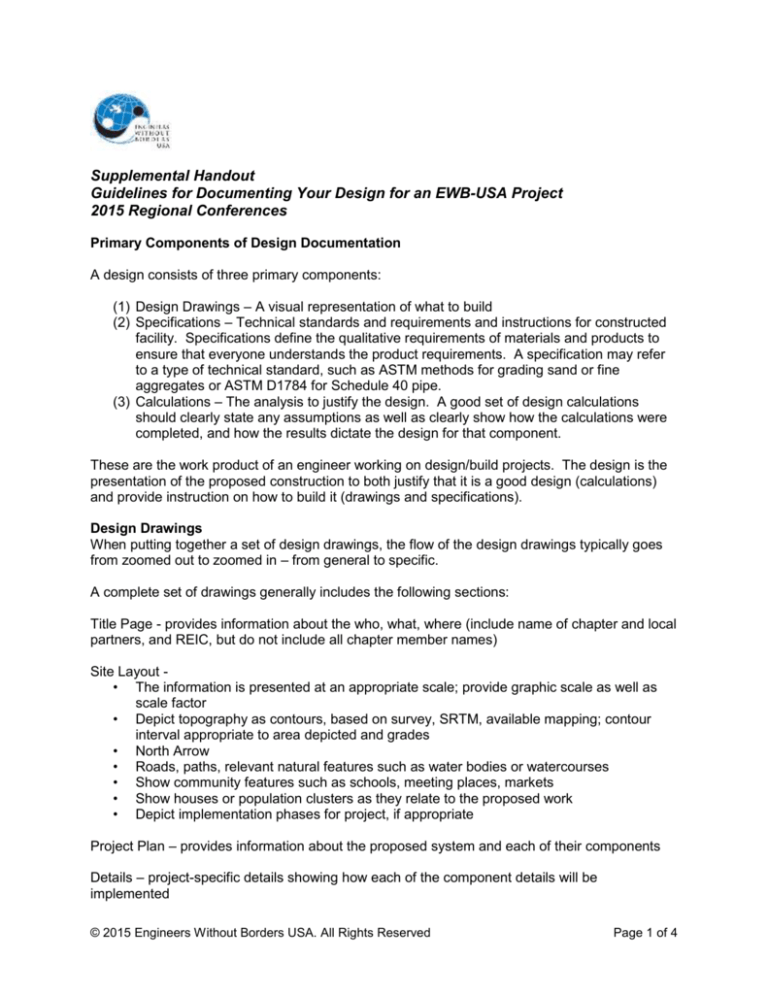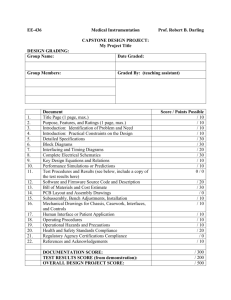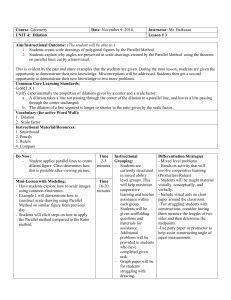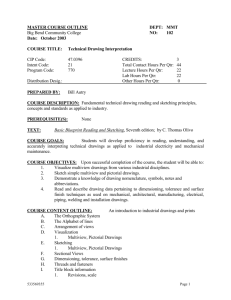
Supplemental Handout
Guidelines for Documenting Your Design for an EWB-USA Project
2015 Regional Conferences
Primary Components of Design Documentation
A design consists of three primary components:
(1) Design Drawings – A visual representation of what to build
(2) Specifications – Technical standards and requirements and instructions for constructed
facility. Specifications define the qualitative requirements of materials and products to
ensure that everyone understands the product requirements. A specification may refer
to a type of technical standard, such as ASTM methods for grading sand or fine
aggregates or ASTM D1784 for Schedule 40 pipe.
(3) Calculations – The analysis to justify the design. A good set of design calculations
should clearly state any assumptions as well as clearly show how the calculations were
completed, and how the results dictate the design for that component.
These are the work product of an engineer working on design/build projects. The design is the
presentation of the proposed construction to both justify that it is a good design (calculations)
and provide instruction on how to build it (drawings and specifications).
Design Drawings
When putting together a set of design drawings, the flow of the design drawings typically goes
from zoomed out to zoomed in – from general to specific.
A complete set of drawings generally includes the following sections:
Title Page - provides information about the who, what, where (include name of chapter and local
partners, and REIC, but do not include all chapter member names)
Site Layout • The information is presented at an appropriate scale; provide graphic scale as well as
scale factor
• Depict topography as contours, based on survey, SRTM, available mapping; contour
interval appropriate to area depicted and grades
• North Arrow
• Roads, paths, relevant natural features such as water bodies or watercourses
• Show community features such as schools, meeting places, markets
• Show houses or population clusters as they relate to the proposed work
• Depict implementation phases for project, if appropriate
Project Plan – provides information about the proposed system and each of their components
Details – project-specific details showing how each of the component details will be
implemented
© 2015 Engineers Without Borders USA. All Rights Reserved
Page 1 of 4
Example Drawing Sets:
Water Supply
The recommended drawing set should include the following:
• Title Page – who, where, what, index of drawings, location plan
• Map of community showing important features and work area and provides context to
the project
• System map showing layout of all components, including source, storage, section
valves, clean-outs, tapstands
• Water System Profile depicting existing grade/pipeline profile, static pressure profile,
and hydraulic grade line in operating state
• Component plans for constructed elements, such as springbox or wellhead, storage
tank, valve chamber, low point drain, tapstand
• Plan, section and critical details of each component
• Foundation or support system, including anchors if necessary
• Provide sufficient dimensions and indicate all materials
• Typical pipe installation details, including trench cross section
• Thrust block details, if appropriate
• Details for handling overflow or tapstand runoff (erosion control)
When designing a pipeline, it’s important to have a pipe plan and profile drawing. This drawing
should include the following:
• Provide baseline with stationing on system plan for reference
• Present information at an appropriate scale; provide vertical exaggeration (typically
10V:1H) if appropriate and provide graphic scales
• Show existing ground surface and pipeline profile
• Show static pressure level for system in unused state
• Depict hydraulic grade line for system in one or more operating conditions – all taps
open, some taps open, varied flow rates
• Show branch lines and critical points such as source, tanks, taps, clean-outs, valves
• Indicate pipe sizes, materials and ratings, particularly if they vary along the profile in
response to system pressure or demand
• Locate any unusual conditions such as road or gully crossings
For rainwater catchment systems, include the following:
• Clearly depict the existing roof structure and how you plan to attach gutters and leaders.
• How will the tank be supported, on a concrete pad or timber platform? Be sure to detail
the structure and ensure that it can support the load.
• Indicate how the tank will be secured to the base so that it cannot be dislodged when
empty.
• If a first-flush is being provided, be sure to provide support for the loaded weight and
erosion protection at the drain.
• Show fill, overflow and drain lines and provide scour protection at overflow and drain
discharges. Consider the users – can they collect water practically?
© 2015 Engineers Without Borders USA. All Rights Reserved
Page 2 of 4
Sanitation
• Title Page
• Site Layout and Site Plan
• Plan and section views
• Wall section of lined pit
• Enclosure details – wall and roof materials, attach to slab or foundation support,
connection of roof to walls, doors, ventilation
• Access hatches or alternating pits for composting latrine
• Details for slab reinforcement and support, lifting points
• If pit is lined, provide wall section and indicate material and reinforcement
• Enclosure details – wall and roof materials, attach to slab or foundation support,
connection of roof to walls, doors, ventilation
Energy
• Title Page – who, where, what, index of drawings, location plan
• Map of community showing important features and identifying buildings to be affected
and panel locations
• Solar panel layout and support
If roof mounted, depict roof framing and mounting details
If free-standing, depict support tower or frame and foundation
• Identify where controls and batteries will be located and how arranged
Demonstrate adequate space, access and ventilation
If new enclosure, provide plans, sections, details
• One-line diagram of electrical components
• Three-wire diagram of electrical system
• Details for grounding and lightning protection
• Details for conduit burial or surface-mounting as appropriate
• Indicate light fixture and outlet types and locations on building plans
Structure / Building
• Title Page – who, where, what, index of drawings, location plan
• Map of community identifying building location relative to other significant community
features
• Site plan at building location showing topography
• Building plan showing exterior walls, interior partitions, doors, windows, fully
dimensioned and depicting wall thicknesses
• Layout and Framing plan for roof
• Typical sections for foundations, wall, floors, interior partitions, roof
• Depict reinforcement within wall sections and at structural components such as headers,
tie beams, columns
• Details for connections between elements (floor, walls, roof)
• Indicate wall and floor finishes, door and window types and sizes
Summary
No matter what you are building, consider the following guidelines:
• Show WHAT you are building, WHERE you are building it, HOW it is put together.
• ZOOM IN on your project through the drawing set:
• Big picture: Where is your community, and who is partnering for your Project?
(Title Page)
© 2015 Engineers Without Borders USA. All Rights Reserved
Page 3 of 4
•
•
•
•
•
•
•
•
•
Where in the community will the project be implemented? (Location or context
plan)
• What are you building, and how does it relate to its site? (Site plan)
• What does the project look like, from above, front, back, sides? (Plan and
elevation views)
• What is it made from? (Typical sections)
• How is it put together? (Details)
Provide a graphic scale as well as noting the scale; if someone plots the drawing at less
than full size, measurement can still be obtained.
Number and date all drawings. Highlight and date any revisions.
Be consistent with dimensions; either metric or English, but not both.
Indicate data sources where appropriate (Google Earth, USGS, etc.)
Where a project such as a roadway or pipeline must be shown across several drawings,
provide a key map and match lines so it is clear how the sheets relate.
Provide a baseline with stationing for linear projects (roads or pipelines), this is critical if
you are providing a profile or cross-sections.
Consider using vertical exaggeration for profiles; 1 Horizontal: 10 Vertical is common.
Label, label, label. Provide references to specific drawings or details as needed.
Common Missteps and Omissions
• How are things held up? Depict and detail pads, towers, supports
• Pipe and conduit installation details / roadway crossings
• Internet-sourced sketches (latrines and springboxes are common) may be helpful
starting points, but be sure that they are relevant to your project and adapt them for your
site geometry and conditions
• If you show a manufacturer’s drawing (such as a precast septic tank), be sure that it
reflects how you plan to build, and provide calculations and design drawings.
• Show wall thicknesses and joinery details on buildings or enclosures
• If you are putting something new (solar panel, rain gutters) on something old (roof or
tower), be sure to accurately measure the existing structure and how it is built so you
can design attachments and verify capacity – or understand what might need to be
modified or rebuilt.
Resources
http://www.ewb-usa.org/resources/
•
•
•
EWB-USA Guidelines (select “Technical Guidelines” filter)
• EWB-USA Bridge Design Guidelines
• Recommendations for PV Projects
• Design Checklist for Rainwater Catchment Projects
• Drilled Well Design Checklist
• Design Checklist for Solar PV Projects
Example Documents (search for “525 example” in search bar)
• Various example 525 Reports
• Various example Drawing Sets
Recorded Presentations (select “Presentation” filter)
• How to Prepare a 525 – Pre-Implementation Report
• Water Supply 3-Part Series
© 2015 Engineers Without Borders USA. All Rights Reserved
Page 4 of 4







